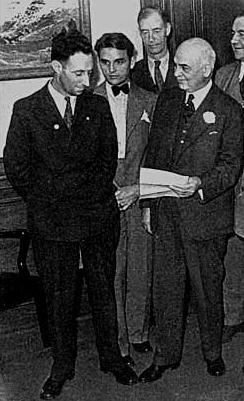Human Flower Project
Monday, September 03, 2007
Florist-Mayors, Folklorist-Shipwrights
With sale of the old city Flower Market and restrictions on street vendors, San Francisco florists are thrust into controversy—again. Who still remembers the florist-mayor of 1934?
For years now, we’ve tried to interest our dear friend and mentor Archie Green – the father of occupational folklore – in our investigations of the lives and work of florists. These people have a hand (or two and both feet) in nearly every human ritual ~ baptisms, pageants, birthdays, and grand openings, weddings, proms, and, of course, funerals.
Like folklorists themselves, florists are attuned to ethnic variations and regional customs; they know that colors and numbers – even scents –all carry symbolic freight. (A good flower shop would never send chrysanthemums to an Italian patient’s bedside or deliver yellow roses to a Persian birthday party.)
Archie, now 90 years old, lives in San Francisco, where he worked as a shipwright before becoming a scholar. He’s spent the last fifty years documenting workers’ culture – the stories of pile drivers and the after-hours sculptures of tin smiths, coal miners’ songs and sailors’ knots. So why does our revered teacher always sniff when we propose studying florists as part of “laborlore”?
This Labor Day, we know why.
 Angelo Rossi, florist and mayor of San Francisco, 1930-1943
Angelo Rossi, florist and mayor of San Francisco, 1930-1943
Photo: Bancroft Library
It goes back to Angelo Rossi, who was San Francisco’s mayor during the historic Longshoremen’s Strike of 1934. Born in 1878, Rossi began his own working life early. By age 10 he was delivering flowers in San Francisco, and he went on to build and head Pelicano Rossi Floral Co. Rossi was appointed as the city’s mayor in 1930, then campaigned and won the office on his own. He served as San Francisco’s mayor for 13 years.
Rossi was in office when the longshoremen who worked on San Francisco’s waterfront called their strike, in May of 1934. The waterfront workers demanded better conditions on the job, larger crews, and—most importantly—the right to unionize. After two strikers were murdered by police on Bloody Thursday, July 5, 1934, their funeral cortege through the city galvanized widespread support from other working people. A general strike ensued.
 Mayor Rossi (with boutonniere) and labor leader Harry Bridges
Mayor Rossi (with boutonniere) and labor leader Harry Bridges
Photo: Museum of San Francisco
Rossi clearly sided with the shipyard owners: “Those who seek to prolong this strike for their own selfish ends or to overthrow the government here in San Francisco or even the Government of the United States will be dealt with by every force of law and order,” he proclaimed in a radio address. The mayor called out hundreds more police and asked the California Governor to send 5,000 national guardsmen into the city.
While historians still debate the outcome of the events in 1934—whether the employers, with Rossi’s help, had triumphed or the longshoremen and their allies prevailed—the florist-mayor’s position was clear: “I pledge to you that as Chief Executive in San Francisco,” Rossi declared, “I will, to the full extent of my authority, run out of San Francisco every Communist agitator.”
No wonder Archie Green has been disinclined to see florists as brothers and sisters in the great family of working people.
Here is Rossi paean to “Conservative Labor” delivered to the AFofL on Labor Day September 1939.
In recent months, we’ve spoken with Archie about the embattled flower sellers of San Francisco. Three weeks ago we learned that half of the San Francisco Flower Market is to be sold— “the so-called ‘Italian’ half of the market, reflecting the heritage of the families, many of them immigrants, who set up the cooperative more than 50 years ago alongside Japanese sellers.” We wonder what Angelo Rossi would say about that, and what advocates of folk culture can do now.
Yes, flower sales have become a municipal issue on several fronts. And more than seventy years after Rossi’s election, another florist is running for mayor of San Francisco. Harold Hoogasian has announced his candidacy. (HFP has written about the Hoogasian family’s long history and leadership of San Francisco’s flower trade before).
 Harold Hoogasian
Harold Hoogasian
florist and candidate for mayor of San Francisco
Photo: Unplug the Machine
“The bottom line is that this city spends money like a drunken sailor,” Hoogasian has said. He contends that a thirty-year career as a florist has prepared him to lead the city. “Florists deal with changing circumstances all the time,” he said. “Many government officials don’t deal with real-time crises. As a florist, you walk in every morning not knowing what’s going to happen by the end of the day.”
We see Hoogasian’s point. And here’s an interesting, if very incomplete, list we came upon of other florists who’ve held political office, among them Burton Cross (former Governor of Maine) and Stanley J. David (longtime mayor of Grand Rapids, Michigan). We hope readers will alert us to other florist-politicians.
Archie, sixty years is a long time to hold a grudge against people who arrange and deliver roses for a living. We’re more determined than ever to document the folkways of florists in “exciting times.” This Labor Day we send thanks and greetings to all working people: trade-unionists and “Conservatives,” mayors, police officers, florists, and folklorists—especially one.




